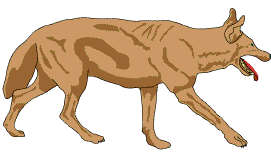|
A Mammoth and a Wolf
One member of the fossil-hunting group discovered the skull of a mammoth
in a bed of gravel. Before the specimen was fully uncovered, he also found
seventeen smaller bones that no one in the group could identify. The boys agreed
that these small specimens could not have been part of the mammoth. Some of them
were complete toe and leg bones, much too small to be mammoth. They recognized
the mammoth skull because one molar was still in place; they had found molars of
mammoths before that had been identified at the university. If the teeth had
been missing, the group could not have determined whether the skull was mammoth
or mastodon. Why?
 In few days the small bones were identified at the university as being
those of a dire wolf, Canis dirus. Now the boys were confronted with
another mystery. How did the remains of a wolf and mammoth come to be buried in
the same sediments? Perhaps the skull was buried upstream after being detached
from the rest of the skeleton and then was washed by the stream to where it was
found. Later, perhaps, the wolf skeleton, also upstream, fell apart, and the
individual bones rolled along with the gravel downstream to the mammoth skull.
The trouble with this hypothesis was that the wolf bones showed no signs (such
as a smooth, polished appearance) of having been rolled along with the gravel by
moving waters. In few days the small bones were identified at the university as being
those of a dire wolf, Canis dirus. Now the boys were confronted with
another mystery. How did the remains of a wolf and mammoth come to be buried in
the same sediments? Perhaps the skull was buried upstream after being detached
from the rest of the skeleton and then was washed by the stream to where it was
found. Later, perhaps, the wolf skeleton, also upstream, fell apart, and the
individual bones rolled along with the gravel downstream to the mammoth skull.
The trouble with this hypothesis was that the wolf bones showed no signs (such
as a smooth, polished appearance) of having been rolled along with the gravel by
moving waters.
The boys speculated also about large hole in the mammoth skull. Did this
hole give a hint as to the cause of death? It looked as if a huge stone had
caused it. Did the animal fall over a cliff, hitting a jagged rock on the way
down or at the bottom? Was the mammoth drinking in a stream at the bottom of a
cliff when an earthquake loosened rocks that tumbled down to crush him? When the
latter possibility was suggested by one of the boys, another countered by
saying: “I don’t think that could have happened. Animals can sense an
earthquake coming before it arrives. They panic and run. Our mammoth wouldn’t
have been anywhere near that stream when the rocks began to fall.”
Another member of the group didn’t think there was much validity in the
last remark. He said: “Suppose animals do sense an earthquake coming and get
panicky. I don’t know where you get your information about this, but it is
possible that our mammoth did get panicky, for some reason, and in his panic ran
right toward the cliff and arrived just as a big rock fell from above.”
How the mammoth and wolf (or the fossilized remains) came to be buried
together is definitely a subject for speculation. In any event, these species
must have played an important role at Irvington. And they must be included in
our reconstruction.
|